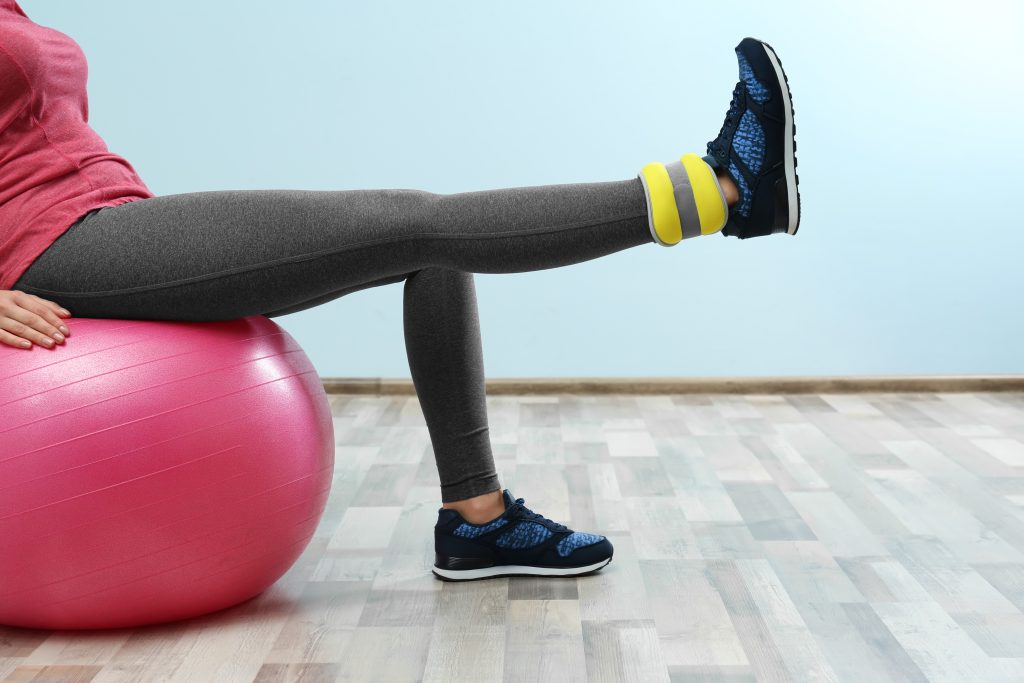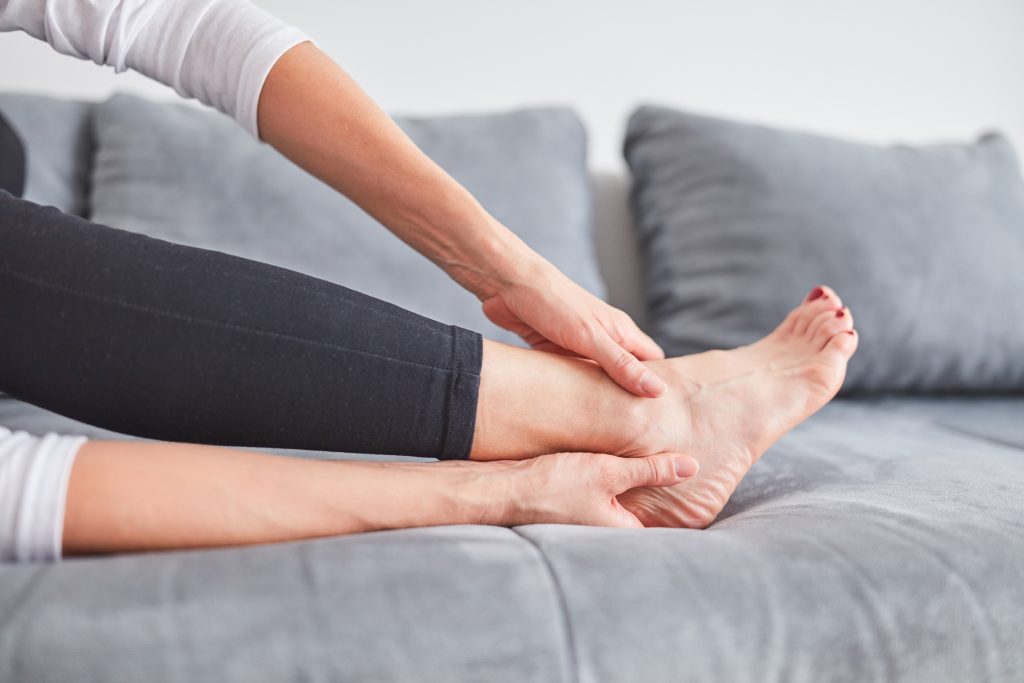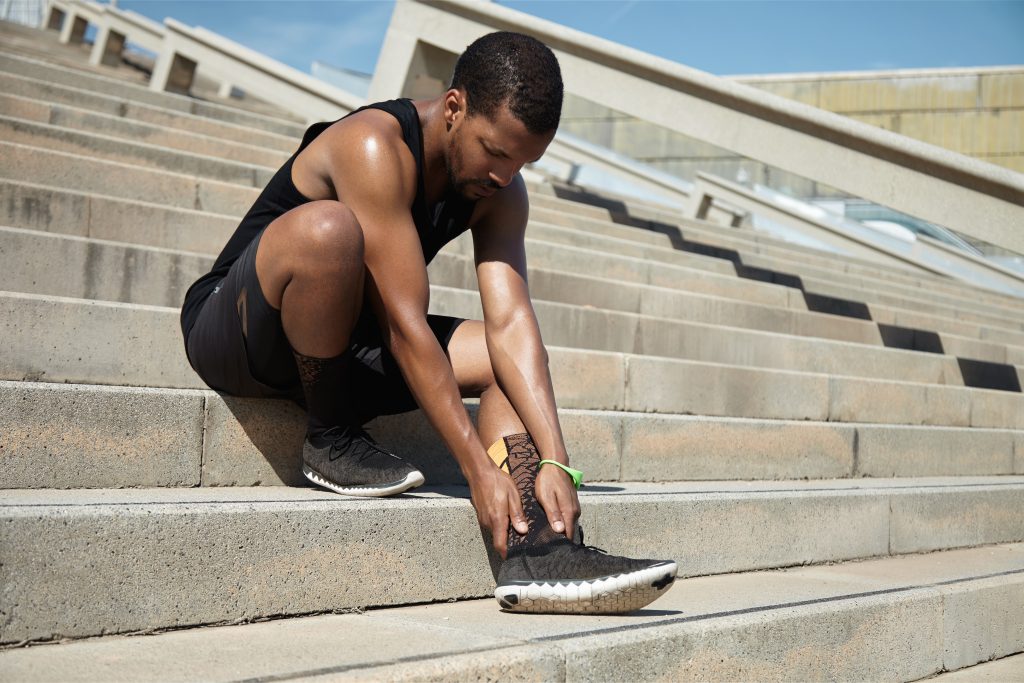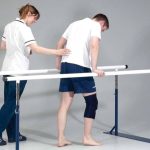What is an Ankle Fracture
An ankle fracture is a break in the integrity of the bones forming the ankle joint. It can occur due to trauma such as a blow, fall, or compression. Ankle fractures vary, but most often, they occur with or without bone displacement.
Features of the Rehabilitation Period
The rehabilitation period after an ankle fracture has its peculiarities, which depend on the severity of the injury, a patient’s age, the presence of concurrent diseases, and individual physiological characteristics. Here are some key aspects to consider during the recovery:
- Immobilization: At the initial stage of rehabilitation, the ankle joint is fixed with plaster or another orthopedic device to provide stability and promote fracture healing.
- Pain and Swelling Control: Pain sensations and swelling may occur during the rehabilitation period. To reduce them, a doctor may prescribe anti-inflammatory drugs, as well as recommend elevating the leg and using cold compresses.
- Blood Circulation Recovery: Improving blood circulation in the area of the trauma helps accelerate the healing process. Patients can perform light exercises for toes and knee joints, as well as make massage and physiotherapeutic procedures on a doctor’s recommendation.
- Motor Function Recovery: After the removal of the plaster, an active stage of rehabilitation begins, where it’s important to restore mobility and flexibility of the ankle joint. Working with a physiotherapist can help develop an individual exercise plan and determine appropriate methods for strengthening muscles.
- Psychological Support: Rehabilitation after an ankle fracture can be an emotionally challenging period for any patient. It’s important to maintain a positive attitude, set realistic goals, and acknowledge achieved successes.
- Adherence to Doctor’s Recommendations: During the entire rehabilitation period, it is extremely important to closely cooperate with healthcare professionals and follow their advice and recommendations. Regular visits to the doctor and performing prescribed exercises and procedures is a guarantee of successful recovery.
- Nutrition and Additional Supplements: A key aspect of rehabilitation is a balanced nutrition, enriched with vitamins and minerals required for bone healing and muscle strengthening. The doctor may also recommend taking specific supplements such as calcium, vitamin D, and other additives that contribute to the recovery.
- Moderate Physical Activity: During the rehabilitation, it’s crucial to gradually increase the load on the ankle joint, avoiding abrupt movements and overexertion. Moderate physical activity will help improve blood circulation, strengthen muscles and joints, and prevent possible complications.
Keep in mind all these peculiarities of the rehabilitation period after an ankle fracture, and it will be easier for you to overcome difficulties and return to an active life. It’s important to remember that each organism is individual, and the speed of recovery can vary. Don’t compare your progress with others, and always follow your doctor’s recommendations.
Physiotherapy Procedures

Physiotherapy procedures play an important role in rehabilitation after an ankle fracture. They contribute to improving blood circulation, reducing swelling and pain, and stimulate tissue regeneration processes. Here are a few main types of physiotherapy that can be used at different stages of recovery:
- Electrotherapy: Includes the use of currents of various frequency and voltage to stimulate nerve and muscle tissues. Electrotherapy helps reduce pain, improve blood circulation, and activate fracture healing processes.
- Ultrasound Therapy: Uses high-frequency sound waves to stimulate cellular processes and improve blood circulation. Ultrasound can help reduce inflammation and swelling, as well as accelerate bone healing.
- Magneto therapy: Magneto therapy uses magnetic fields to stimulate cellular processes and improve blood circulation. The procedure can help reduce pain, accelerate bone healing, and improve the overall health condition of the patient.
- Laser Therapy: Laser therapy is used to stimulate tissue regeneration and accelerate the fracture healing process. Laser radiation can also help reduce swelling and inflammation in the area of injury.
- Hydrotherapy: Hydrotherapy, or water treatment involves the use of water of different temperatures and pressure to improve blood circulation and reduce pain. Foot baths, contrast showers, and swimming can be recommended at the later stages of rehabilitation.
When selecting a physiotherapy method, the doctor considers the individual characteristics of any patient, the stage of fracture healing, and the presence of contraindications. It is necessary to strictly follow the specialist’s recommendations and perform procedures only after they have been prescribed and under the control of a doctor. A comprehensive approach to physiotherapy, combining different methods, and regularity of procedures will help accelerate the recovery process and reduce the risk of complications.
Leg Massage After a Fracture
Massage is an important element of the rehabilitation process after an ankle fracture. It contributes to improving blood circulation, reducing swelling and pain, and restoring muscle tone and maintaining joint flexibility. A massage should be carried out only after consultation with a doctor and taking into account the individual characteristics of the patient. Here are some main aspects of leg massage after an ankle fracture:
- Types of massage: Depending on the stage of rehabilitation and the patient’s health condition, various types of massage can be used, such as lymphatic drainage massage, classic massage, soft massage, or point massage. The doctor and massage therapist will determine the most suitable type of massage based on the individual characteristics of the patient.
- Massage techniques: Various techniques can be used during the massage, such as stroking, rubbing, kneading, vibration, etc. The selection of techniques depends on the goals of the massage and the patient’s condition.
- Starting the massage: Massage after an ankle fracture usually begins with gentle stroking and warming up the muscles, gradually increasing the intensity of the movements. It’s important to watch the patient’s reaction and avoid too much pressure on the fracture area.
- Joint massage: During the massage, special attention is given to the ankle joint and its surrounding muscles. The massage therapist may use gentle techniques to restore flexibility and mobility to the joint, preventing stiffness and improving leg functionality.
- Duration and frequency of massage: The duration and frequency of the massage are determined by the doctor and massage therapist based on the patient’s condition and stage of rehabilitation. Typically, massages are performed 2-3 times a week, for 20-30 minutes per session.
- Massage contraindications: In some cases, massage may be contraindicated. These situations include active inflammation, infection, purulent processes, thrombosis, high temperature, or the presence of oncological diseases. Before starting a massage, make sure the doctor has allowed this type of therapy.
- Preparation for massage: Before starting the massage, make sure the patient is in a comfortable position and place a soft pillow or roller under the leg to relieve pressure on the fracture area. It is also recommended to use massage oil or cream to improve hand glide over the skin and prevent irritation.
- Completion of massage: At the end of the massage, the massage therapist should smoothly complete all the techniques and give the patient time to rest and recover. It is recommended to drink a glass of water to help the body eliminate wastes and toxins that were released during the massage.
By adhering to these basic principles and recommendations, massage after an ankle fracture can become an effective rehabilitation tool that will help restore leg functionality, reduce pain, and improve the overall quality of life for the patient.
Features of Physiotherapy at Different Stages of the Recovery
Physical therapy is important for restoring the function of the ankle joint. Different exercises are used at different stages of rehabilitation, depending on the degree of fracture healing and the condition of the joint.

Physical Therapy During Cast Wear for Ankle Fracture
Physical therapy plays an important role in rehabilitation after an ankle fracture. It helps restore joint mobility, improves muscle tone, reduces pain, and swelling. Different stages of rehabilitation require different approaches to physical therapy. In this section, we will cover the specifics of physical therapy during cast-phase, after cast removal, and prohibited exercises after an ankle fracture.
Physical therapy during the cast-phase for an ankle fracture
At this stage of rehabilitation, the main goal of physical therapy is to prevent muscle weakness and maintain joint mobility. It is important to avoid physical strain on the affected leg, as this can cause additional injuries and worsen the condition. The following types of exercises are recommended the cast-phase wear:
- Upper body exercises such as arm raises, circular shoulder movements, torso bends, and twists.
- Contracting and relaxing the thigh and buttock muscles on the affected leg.
- Isometric exercises for calf muscles such as clenching and relaxing the calf.
- Exercises for the unaffected leg such as toe and heel raises, knee joint flexion and extension.
Physical Therapy after Ankle Fracture and Cast Removal
After cast removal, the main goals of physical therapy are to restore ankle joint mobility, strengthen muscles, and return to full physical activity. At this stage, the following exercises are recommended:
- Active and passive movements in the ankle joint: flexion, extension, inversion, and eversion.
- Balance and stabilization exercises such as standing on one leg, shifting weight from one leg to another, and using a balance board.
- Exercises to strengthen the calf, thigh, and buttock muscles such as toe and heel raises, squats, lunges, and lying on your side, raising and lowering your leg.
- Swimming and aqua aerobics, which will help restore joint mobility and strengthen muscles without excessive strain on the leg.
- Walks and gradual increase in walking distance and intensity.
It’s important to take into account individual characteristics of the patient and the progress of recovery. All exercises should be performed without pain and discomfort. In case of pain, the intensity of exercises should be reduced or temporarily discontinued.
Prohibited Exercises After Ankle Fracture
Some exercises may be dangerous and cause harm during the recovery process after an ankle fracture. The following exercises should be avoided:
- Exercises with fast and abrupt movements, such as jumps and running.
- Exercises with a high load on the ankle joint, such as weightlifting and leg weightlifting.
- Exercises with an increased risk of injury, such as contact sports or extreme activities.
When performing physical therapy after an ankle fracture, it is important to carefully monitor your health condition, listen to your body, and follow the doctor’s recommendations. Gradual and correct performance of exercises will help successfully restore leg functionality and return to active life.
How Long the Rehabilitation Takes
The duration of the rehabilitation after an ankle fracture can vary depending on the severity of the injury and individual body characteristics. On average, the recovery process can take from 3 months to 1 year.
Nutrition Details
Nutrition is one of the key factors for successful rehabilitation after an ankle fracture. Consuming enough nutrients, vitamins, and minerals will help accelerate the bone healing process and muscle recovery. In this section, we will look at nutrition features, beneficial products, and their content of vitamins and minerals.

Proteins
Proteins are an important building material for muscles and bones. During the rehabilitation after an ankle fracture, it is recommended to increase protein intake. Excellent sources of protein are:
- Meat (chicken, turkey, beef, pork)
- Fish (salmon, tuna, cod)
- Dairy products (cottage cheese, yogurt, cheese)
- Legumes (peas, beans, lentils)
- Eggs
- Nuts and seeds (almonds, walnuts, flax seeds)
Calcium
Calcium is necessary for healing fractures and maintaining bone health. Main sources of calcium:
- Dairy products (milk, cheese, yogurt)
- Green leafy vegetables (spinach, broccoli, cabbage)
- Fish (sardines, salmon, cod)
- Nuts and seeds (almonds, walnuts, sesame)
- Legumes (beans, peas, soy products)
Vitamin D
Vitamin D helps absorb calcium and strengthen bones. Sources of vitamin D:
- Fish (salmon, herring, mackerel)
- Eggs (yolk)
- Dairy products (milk, cheese, yogurt)
- Mushrooms (shiitake mushrooms, champignons)
Magnesium
Magnesium is important for muscle function and overall bone health. Products rich in magnesium:
- Green leafy vegetables (spinach, chard)
- Nuts and seeds (walnuts, cashews, pumpkin seeds)
- Legumes (beans, peas, lentils)
- Cereals (buckwheat, quinoa, oatmeal)
- Bananas and avocados
Vitamin C
Vitamin C plays a vital role in the healing process of wounds and strengthening the immunity. Foods containing vitamin C:
- Citrus fruits (oranges, grapefruits, mandarins)
- Red and green peppers
- Kiwi
- Broccoli
- Berries (strawberries, raspberries, currants)
Zinc
Zinc is involved in the healing process and supports the immune system. Sources of zinc:
- Meat (beef, lamb, pork)
- Fish and seafood (oysters, crabs, shrimp)
- Nuts and seeds (pumpkin seeds, sunflower seeds, almonds)
- Grains (buckwheat, wheat, rice)
During the rehabilitation after an ankle fracture, it is important to maintain a balanced diet, enriched with the aforementioned products. It is also recommended to avoid excessive consumption of salt, sugar, fats, and alcohol, which may slow down the recovery process. Regular consumption of beneficial foods, rich in vitamins and minerals, will help accelerate the healing of the fracture and ensure a successful restoration of leg functionality.
Medications
During the rehabilitation after an ankle fracture, various drugs may be prescribed to alleviate pain, reduce inflammation, and accelerate healing. Below is a list of main medications:

Analgesics
- Paracetamol: relieves pain, can be used for mild to moderate pain.
- Ibuprofen or Naproxen: non-steroidal anti-inflammatory drugs (NSAIDs), relieve inflammation and pain.
- Ketorolac or Diclofenac: strong NSAIDs, used for severe pain.
Anti-inflammatory Drugs
- Prednisolone or Hydrocortisone: corticosteroids, have pronounced anti-inflammatory and anti-allergic effects.
Bone-Strengthening Drugs
- Calcium gluconate or Calcium citrate: sources of calcium, necessary for bone strengthening and fracture healing.
- Cholecalciferol (vitamin D3) or Ergocalciferol (vitamin D2): vitamin D, promotes calcium absorption and bone strengthening.
- Complex formulations with calcium, vitamin D, and magnesium: provide the body with all necessary substances for healing fractures and strengthening bones.
Vasodilators and Drugs to Improve Microcirculation
- Pentoxifylline: improves blood microcirculation and increases the permeability of blood vessels, contributes to the improved blood supply to damaged tissues.
- Nicotinic acid: dilates blood vessels and improves blood flow, contributes to the improvement of tissue blood supply.
Chondroprotectors
- Glucosamine or Chondroitin sulfate: restore and protect cartilage tissue, contribute to the improvement of joint mobility after a fracture.
Tissue Regeneration Enhancers
- Actovegin or Solcoseryl: accelerate the process of regeneration and tissue healing, contribute to the recovery of damaged areas.
Drugs for the Prevention and Treatment of Osteoporosis
- Bisphosphonates (Alendronate, Risedronate): slow down the process of bone tissue destruction and accelerate its restoration, are used in osteoporosis to prevent further bone destruction.
Drugs for the Prevention of Thrombosis
- Aspirin or Clopidogrel: anticoagulants, prevent the formation of blood clots, contribute to the prevention of thrombosis during a prolonged immobilization.
Antibiotics (if necessary)
- Amoxicillin, Ceftriaxone or Cefazolin: are used in the presence of infectious complications, such as purulent osteomyelitis or phlegmon.
It should be noted that of drugs should be prescribed exclusively by a doctor, taking into account individual characteristics and the patient’s condition. It is not recommended to use drugs independently without consulting a specialist. Follow the doctor’s instructions and dosage recommendations to achieve a maximum treatment effect and successful rehabilitation after an ankle fracture.
Complications that Prolong Rehabilitation Time

During the rehabilitation after an ankle fracture, various complications may arise that prolong recovery time and require additional treatment. Below are the main complications and their impact on the rehabilitation process:
Infectious Complications
Purulent osteomyelitis: an infection of the bone tissue, which can develop due to inadequate wound care or poor antibacterial treatment. Leads to additional bone destruction and prolongation of recovery time.
Phlegmon: purulent inflammation of soft tissues, requires antibacterial treatment and sometimes surgical intervention.
Thrombosis
Deep vein thrombosis: the formation of blood clots in the deep veins of the leg, usually related to a prolonged immobilization. Requires immediate treatment with anticoagulants and possibly wearing compression underwear.
Contractures and Muscle Atrophy
Joint contractures: reduction in joint mobility due to the prolonged immobility and poor rehabilitation. May require additional time to restore joint mobility with physical therapy and massage.
Muscle atrophy: reduction in muscle volume and strength due to the prolonged immobility. Requires additional time to restore muscle mass and strength with physical activity and physical therapy.
Non-union or Slow Healing of the Fracture
Non-union: the absence of bone healing after a fracture. May require re-surgery and long rehabilitation.
Delayed healing: bones heal slower than usual. Requires additional time for rehabilitation and possibly the use of medications to stimulate bone tissue growth.
Osteoporosis
Decreased bone density can lead to recurrent fractures and slow the fracture healing process. Requires the use of specific drugs to strengthen bone tissue and prevent further destruction.
Nerve and Vessel Damage
Neuropathy or vessel damage in the area of the fracture can cause sensitivity disorders, pain, and swelling, which slows down the rehabilitation process. Additional treatment and rehabilitation measures may be required to restore normal nerve and vessel function.
Impairment of Ankle Joint Biomechanics
After an ankle fracture, there may be disturbances in the biomechanics of the ankle joint, which can cause lameness, pain, and discomfort when walking. In such cases, an individualized physical therapy program is needed and, possibly, the use of orthopedic insoles to correct disorders.
It’s important to remember that regular adherence to doctor’s recommendations and active participation in the rehabilitation process will help minimize the risk of complications and accelerate recovery after an ankle fracture. If you notice any problems or complications, be sure to contact your doctor to get additional recommendations and modification of the treatment plan.
Home Rehabilitation
For successful recovery at home, you should perform physical therapy exercises, massage, wear orthopedic devices if necessary, and follow the doctor’s recommendations on nutrition and medication intake. Don’t forget about regular visits to the doctor to monitor the condition of the ankle joint.
Injury with Displacement
In case of an ankle fracture with displacement, rehabilitation may take more time due to the complexity of the injury and the need for surgical intervention. In this case, special attention is paid to restoring the correct position of the bones and their fusion.
Injury without Displacement
In case of a fracture without displacement, rehabilitation is faster as the bones remain in the correct position. However, it is necessary to strictly follow all the doctor’s recommendations and monitor the fracture healing process.
Video: “Ankle Joint Recovery after Fracture”
EXERCISES FOR THE ANKLE JOINT. SET №6E IS AIMED AT STRENGTHENING OF THE MUSCLES AND IMPROVEMENT OF PROPRIOCEPTION AND STABILITY OF THE ANKLE AND ENTIRE LOWER LIMB. MID STAGE
For additional information about the recovery process after an ankle fracture, you can watch a video demonstrating exercises and rehabilitation recommendations.
How to Train the Leg after a Fracture

Training the leg after an ankle fracture involves a complex of exercises at different stages of rehabilitation, massage, and a gradual increase in load on the ankle joint. Working with a physiotherapist can help determine the optimal recovery plan for your situation.
What is a Contraindication for Massage and Physiotherapy
Contraindications for massage and physiotherapy are infections, thrombosis, high temperature, oncological diseases, and uncontrolled arterial hypertension. Always consult with a doctor before starting massage or physiotherapy.
Massage
Massage after an ankle fracture promotes improved blood circulation, reduces swelling, and accelerates the recovery process. It’s important to consult a qualified massage therapist who is familiar with the specifics of rehabilitation after an ankle fracture to avoid additional injuries and complications.
Physiotherapy
Physical therapy plays a key role in rehabilitation after an ankle fracture. Exercises help strengthen muscles, develop flexibility, and improve the overall function of the ankle joint. Work with a physiotherapist to develop an individual exercise plan that suits your needs and the degree of fracture healing.
Conclusion
Rehabilitation after an ankle fracture is a complex and prolonged process, requiring time, patience, and strict adherence to the doctor’s recommendations. It’s important to pay attention to physiotherapy, massage, physical exercises, nutrition, and medication intake to achieve optimal recovery results.
We strongly recommend watching the videos on our website, which contain useful information about recovery after an ankle fracture. These videos will help you better understand the rehabilitation process, master the correct techniques of performing exercises and massage, and provide additional care tips for the ankle joint during fracture healing.
Don’t forget to consult with specialists and follow their recommendations to accelerate the healing process and return to an active life without limitations. Your health and successful recovery are our top priority.
Check out the demo version of our sets of exercises for the Lower Limb Problems on YouTube
You can find more information about the Lower Limb Problems in our Library of Articles
Our website presents sets of exercises for rehabilitation of the ankle joint in the following four areas:
EXERCISES FOR THE ANKLE JOINT. SET №5 IS AIMED AT STRETCHING THE MUSCLES (IMPROVEMENT OF FLEXIBILITY OF THE MUSCULAR APPARATUS) AND INCREASE OF THE RANGE OF JOINT MOVEMENT
EXERCISES FOR THE ANKLE JOINT. SET №6D IS AIMED AT STRENGTHENING OF THE MUSCLES AND IMPROVEMENT OF PROPRIOCEPTION AND STABILITY OF THE ANKLE AND ENTIRE LOWER LIMB. INITIAL STAGE
EXERCISES FOR THE ANKLE JOINT. SET №6E IS AIMED AT STRENGTHENING OF THE MUSCLES AND IMPROVEMENT OF PROPRIOCEPTION AND STABILITY OF THE ANKLE AND ENTIRE LOWER LIMB. MID STAGE
EXERCISES FOR THE ANKLE JOINT. SET №6F IS AIMED AT STRENGTHENING OF THE MUSCLES AND IMPROVEMENT OF PROPRIOCEPTION AND STABILITY OF THE ANKLE AND ENTIRE LOWER LIMB. ADVANCED STAGE
In addition to the listed sets of exercises in the Lower Limb Problems section there are sets of exercises for the rehabilitation of the knee joint, pelvic girdle and hip joint



